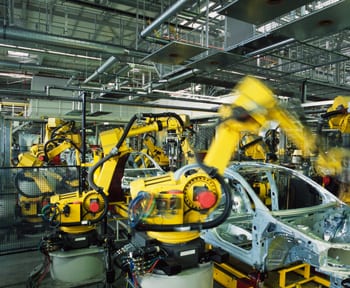Keeping a Competitive Future for Ontario’s Automotive Industry

An article recently published in The Hamilton Spectator identified the Ontario automotive sector as lacking leadership and on the verge of a decline. Although the Ontario industry was a top global contender, manufacturers of vehicles and automotive components in Ontario are facing downward pricing pressures from developing nations with low labour rates, and consumer preferences are shifting towards electric vehicles (EV) to which Ontario does not have the resources to remain competitive. If Ontario wishes to compete as a top player in the automotive industry, there needs to be a shift towards higher innovation and productivity, as well as retooling of plants that are geared towards electric vehicles. Failure to do so will increase the industry’s reliance on provincial investments which have uncertain, temporary benefits.
A Non-Environmental Case for Electric Vehicle Production
Former Ontario Premier, Dalton McGuinty, was the last to push for EV production increases in Ontario. In 2009, he stated the government’s goal to have one in every 20 cars driven in Ontario to be electrically powered (whether it be a hybrid, plug-in hybrid, or all-electric), provided up to $10,000 in rebates for Ontarians to buy EVs, and championed the extension of high-occupancy vehicle (HOV) lane use to include electric cars. While there was a good reason to do this environmentally, the focus was also on job creation.
The automotive industry on a global level is just beginning their shift towards low-carbon vehicles, and retooling production facilities to capture more of this market should be a key priority. Electric battery and engine technology remains in its infancy, and if Ontario could establish itself as a research and development hub for EV technologies, then the province’s potential for the future would increase dramatically. The only electric-powered passenger vehicle currently produced in Ontario is the Lexus RX 450h hybrid, manufactured in Toyota’s Cambridge facility. Outside of this one vehicle, production of all other electric vehicles comes from other automotive hubs, including Michigan. Michigan has made the switch over to EV technology, manufacturing the Chevy Volt, along with its batteries and battery packs. Ford has also used the northern United States auto hub to produce its Ford Focus Electric model. Other EVs, such as the Nissan Leaf and Tesla models are currently being produced in the southern United States. Most of Canadian-driven electric vehicles are being produced in the U.S. and imported across the border, however Ontario could be supplying these vehicles if automotive manufacturers had a greater focus on innovative technologies.
Shifting the Automotive Industry Focus towards Innovation
In the automotive industry, vehicle assembly is often seen as the lowest-value adding stage of the process. Josipa Petrunic, Executive Director of the E-Mobility Program at McMaster University’s Institute for Transportation and Logistics, said “who cares?” that we’re losing assembly jobs. In the long-run we will not be able to keep up with Mexico, Asia, or other low labour rate nations who are able to assemble vehicles cheaper than manufacturers can legally accomplish in Ontario. The result is provincial and federal governments handing money to manufacturers to keep production local. Instead, Ontario should be focusing on building innovation capacity, and vehicle innovation is growing mostly through EVs right now. By demonstrating leadership in innovation, these manufacturing jobs will naturally follow as they have in the northern U.S.
Currently, 22 Canadian universities (of which 10 are located in Ontario) are involved in electric transportation research. This is vital for technology development and having a new generation of graduates enter the labour market who have worked with the technology before. New, innovative EV companies are a natural by-product of having more professionals trained in electric transportation. For example, CrossChasm Technologies is an EV analytics and simulation company created out of the University of Waterloo. The company designs software which allows electric vehicles the ability to communicate more effectively with charging stations, other cars, and drivers. Having more EV innovation companies such as CrossChasm Technologies will increase the value that Ontario provides to the manufacturing sector and will bring high-paying, high-skilled jobs to the province. After re-establishing Ontario as an auto innovation centre, more automotive companies will resume parts manufacturing and vehicle assembly closer to the source of growth.
What is Being Done to Increase Ontario’s Performance?
When asked if the Province of Ontario has a strategy to rebuild its automotive industry, Minister of Economic Development, Brad Duguid provided some insight into what is currently being done. He noted that continuing rebates for Ontario residents to buy EVs would help to stimulate automotive companies to realizing there is market potential here, which is the first step towards receiving investment towards retooling facilities towards EV models. Also, investing in companies providing innovative electric technology, such as lithium-ion battery developer Electrovaya, would increase the amount of firms researching, developing, and commercializing these products to sell to all of the major manufacturers.
“We will continue working with all our automotive partners to ensure Ontario is a leader in next generation production and that Ontario continues to produce electric vehicles”
– Brad Duguid, Ontario Minister of Economic Development, Employment and Infrastructure
Also favouring the rebound of Ontario’s automotive sector is the formation of a new Canadian Automotive Partnership Council (CAPC) subcommittee aimed at providing the government and businesses with advice on investment initiatives. Chaired by Ray Tanguay, who formerly held a leadership position with Toyota, this subcommittee will advise how to best stimulate the sector and prepare it for future success. Actions the government and businesses take now will ultimately impact the health and success of the auto industry five to ten years down the road, approximately the same time that EVs will begin to receive widespread adoption. Investing in innovation will establish Ontario as a future leader, and create a self-sustaining industry.
Canadian Government Funding for Automotive Innovation
It’s expected that Canada’s investment into innovative auto manufacturers will rise, however there are programs currently available which businesses may use to develop new technologies. Projects with a high degree of innovation, such as the development of EV technology, are prime applicants for programs such as:
The Automotive Supplier Innovation Program (ASIP) received a total funding pool of $100 million which is to be disbursed to create new technologies for automotive suppliers. Businesses may receive up to $10 million or 50% of eligible costs, in Canadian government grants for product and process development projects such as product engineering, prototyping, and pre-commercial testing. The program was launched this year (2015) and will run through 2020, however funding is provided on a first-come, first-served basis.
Additionally, the Automotive Innovation Fund (AIF) provides Canadian government loans for large-scale research and development projects. Specifically geared towards building more innovative, environmentally-friendly vehicles and vehicle components, AIF provides 10-15% of eligible costs for projects which have a total spend of at least $75 million.
Alternately, businesses may wish to collaborate with one of the many Canadian universities which are conducting research on electric transportation. NSERC Engage provides up to $25,000 in government grant funding to an industry academic partnership. The program will match a Canadian university professor and team of graduate students with a business’ technological challenge to be solved over a 4-6 month period. This has been successfully used when businesses have the resources needed to research and design new technologies of their own, but are not able to test the innovative solution.
More Resources for Innovative Automotive Technology Companies
If you have questions about any of the programs listed above or wish to learn about other Canadian government grants and loans, please contact Mentor Works and one of our Government Funding Experts will assist you in determining which opportunity will best enable your business’ growth and innovation. Mentor Works frequently hosts educational webinars about funding for innovation, research and development, and the manufacturing sector as a whole. View our list of upcoming webinars and receive complimentary registration to start your business’ funding activities. For weekly government funding news, such as this article, delivered to your inbox, register for Mentor Works’ funding e-newsletter where we’ll keep you informed of all of the information you need to know.

